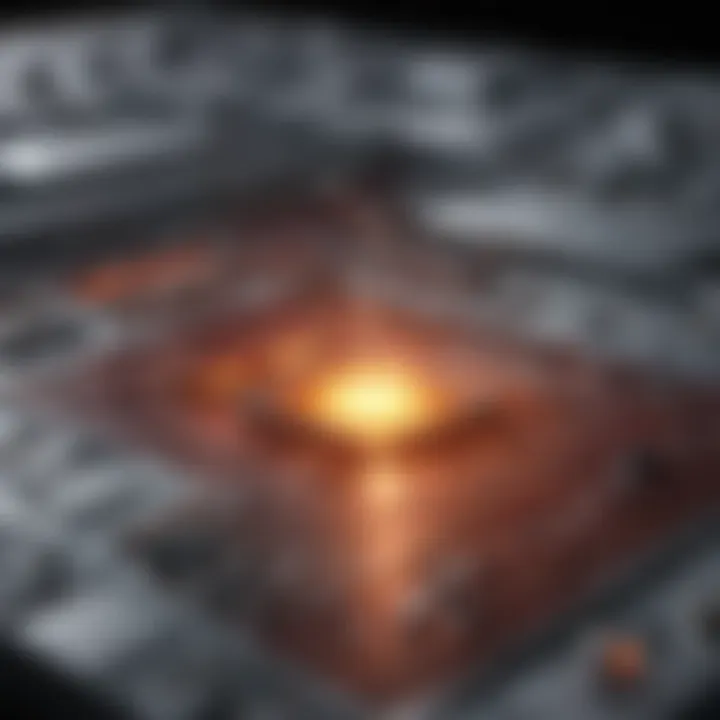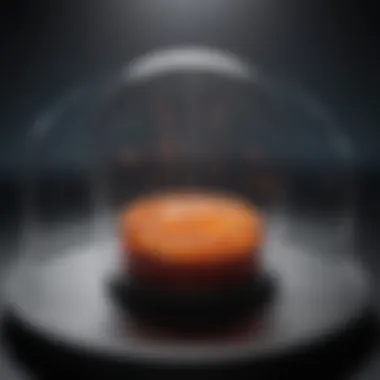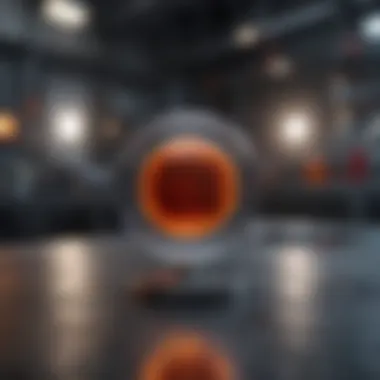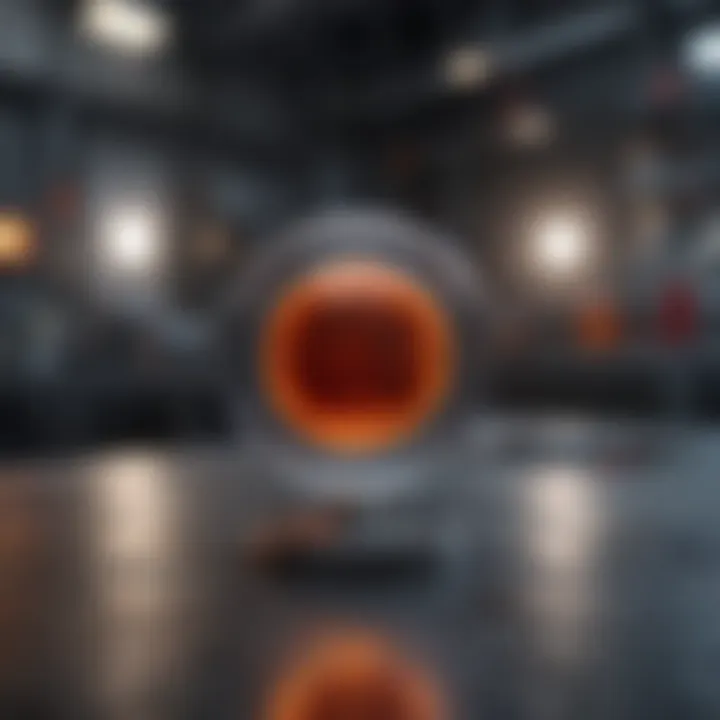Exploring Peltier Technology: Principles and Applications


Intro
Peltier technology is a unique thermoelectric principle that enables the transfer of heat by utilizing semiconductor materials. This energy conversion method is based on the Peltier effect, which occurs when electric current flows through materials, leading to the absorption or release of heat. The significance of this mechanism lies in its diverse application across multiple fields, ranging from cooling devices to energy solutions.
Understanding the core principles of Peltier technology allows one to appreciate its potential in modern industry and scientific research. This article aims to explore the fundamental aspects of Peltier devices, their relevance to real-world applications, challenges faced in their implementation, and future developments in the field.
By dissecting each of these components, the article aspires to provide a thorough examination of Peltier technology, thus catering to an audience that includes students, researchers, educators, and professionals looking to deepen their knowledge on this promising subject.
Understanding Peltier Technology
Peltier technology represents a pivotal field in thermoelectric science and its applications are extensive. It harnesses the principles of thermoelectricity to create devices capable of achieving temperature control through electronic means. This is fundamentally important in today's technology-driven society, where energy efficiency and compact design are key considerations. Understanding this technology allows researchers, engineers, and enthusiasts to explore innovative solutions to energy challenges facing various sectors in modern industry.
Definition of Peltier Technology
Peltier technology refers to a thermoelectric phenomenon where heat is either absorbed or expelled when an electric current flows through a junction of two different materials. This effect enables cooling or heating without the need for moving parts, making devices that utilize this technology highly reliable and low maintenance. Peltier devices, known as thermoelectric coolers or Peltier modules, exploit this principle to achieve temperature control in various applications.
Historical Background
The foundation of Peltier technology is traced back to the mid-19th century when Jean Charles Athanase Peltier discovered the thermoelectric effect in 1834. His research established critical relationships between electricity and temperature changes in different materials. Over the decades, this phenomenon has supported advancements in materials science allowing for the development of effective thermoelectric materials. The evolution continued through the 20th century, with significant application in refrigeration and electronics cooling systems seen from the 1960s onward.
Key Scientific Principles
Thermoelectric Effect
The thermoelectric effect serves as the fundamental principle of Peltier technology. It defines how heat moves in response to voltage applied across materials. This effect is characterized by the ability to convert thermal energy directly into electrical energy and vice versa.
Its significance lies in its solid-state nature, providing advantages such as no moving parts, thus resulting in less mechanical wear-and-tear. This makes it a compelling choice, especially in scenarios where reliability is crucial. However, the performance of thermoelectric materials often depends on temperature gradients, which can limit efficiency across various applications.
Seebeck Effect
A specific aspect of the thermoelectric effect is the Seebeck effect, where a temperature difference between two conductors generates an electrical voltage. This phenomenon allows for energy harvesting from heat sources, making it relevant for applications like waste heat recovery. The characteristic feature of the Seebeck effect is its ability to produce power from temperature differentials. Despite its potential, challenges remain in maximizing the efficiency of the generated output, which can limit practical utility.
Thomson Effect
The Thomson effect describes the heating or cooling of a current-carrying conductor depending on the direction of current flow in a temperature gradient. This effect contributes further to understanding thermoelectric phenomena but is generally less emphasized in Peltier technology. Its key attribute makes it valuable for fine temperature control in applications needing precision. Nevertheless, its complexity and the intricacy of integrating this effect into practical systems can deter its application in some scenarios.
Overall, these key scientific principles inform the utility and progression of Peltier technology, paving pathways for innovation and sustainability in numerous fields.
Mechanisms Behind Peltier Devices
Understanding the mechanisms behind Peltier devices is crucial for comprehending how these systems function effectively. Peltier devices, often referred to as thermoelectric coolers, utilize the principles of thermoelectricity to transfer heat. This section examines the intricacies that underscore their design, operation, and overall efficiency. By exploring the structure of thermoelectric materials, the operation of Peltier junctions, and the dynamics of heat transfer, one can appreciate both the potential and limitations of this technology.
Structure of Thermoelectric Materials
The foundation of any Peltier device lies in the thermoelectric materials used to construct it. Typically, these materials possess semiconductor properties that are essential for their operation. They predominantly fall into two categories: n-type and p-type semiconductors.
- N-type semiconductors are characterized by extra electrons in their structure. These electrons act as charge carriers, allowing electricity to flow, while also facilitating heat transfer.
- P-type semiconductors, on the other hand, have fewer electrons, creating 'holes' that can also carry charge and heat.
Together, these materials form a thermoelectric circuit when connected in a Peltier module. The arrangement of these semiconductors allows for efficient heat absorption from one side and heat dissipation from the other. This structure is crucial for enabling the cooling effect that makes Peltier devices valuable across various applications.
Operation of Peltier Junctions
Peltier devices operate based on a phenomenon known as the Peltier effect, which describes the heat absorbed or released when electric current flows through two different conductors. When voltage is applied to a Peltier junction—essentially the point where an n-type and a p-type material connect—heat is either absorbed or expelled. This effect can be summarized as follows:


- Heat Absorption: On the side of the junction where the current enters, heat is absorbed, resulting in cooling. This is vital for temperature regulation in applications such as electronic cooling.
- Heat Dissipation: On the opposite side, where the current exits, heat is released into the ambient environment. This heat transfer must be efficient to maintain the overall effectiveness of the Peltier device.
The efficiency of this operation is directly impacted by the materials used and the design of the junction. Efficiency improvements are a significant focus in ongoing research in the field.
Heat Transfer Dynamics
An understanding of heat transfer dynamics is essential for optimizing Peltier devices. The transfer of heat in these systems occurs through conduction, convection, and radiation:
- Conduction happens between the component materials when heat moves from a hotter to a cooler area through direct contact.
- Convection plays a role when air or another fluid circulates around the device, carrying heat away from the hot side and allowing more cooling on the cold side.
- Radiation may also dissipate heat, albeit to a lesser extent compared to conduction and convection.
Optimizing these mechanisms requires careful design to enhance thermal contact and improve airflow. Enhancing the operational efficiency leads to more effective cooling solutions and energy savings.
"The mechanisms behind Peltier devices are not merely technical details; they represent the intricacies that can determine the success or failure of thermoelectric applications."
In summary, the mechanisms underlying Peltier devices are complex but essential for proper function. By understanding the structure of thermoelectric materials, the operation of Peltier junctions, and the dynamics of heat transfer, one can improve the application and future developments of Peltier technology.
Applications of Peltier Technology
The applications of Peltier technology demonstrate its versatility and importance across various sectors. It plays a significant role in innovations that require efficient heat management solutions. From electronics cooling to power generation, this technology is essential in developing modern systems. Understanding these applications allows stakeholders to appreciate the practical implications of thermoelectric principles in day-to-day operations and future developments.
Cooling Systems
Consumer Electronics
In consumer electronics, Peltier devices are often used for cooling purposes. They harness the thermoelectric effect to move heat away from components like CPUs and GPUs, ensuring optimal performance. A key characteristic of these systems is their solid-state operation, which means they have no moving parts. This feature leads to lower maintenance requirements and increased reliability.
A unique aspect of using Peltier technology in consumer electronics is its compact size. Small form factors allow designers to integrate cooling directly into the product's architecture. However, one disadvantage is the energy efficiency of Peltier devices, as they can consume significant power under higher loads.
Industrial Refrigeration
Peltier technology also finds a place in industrial refrigeration. These systems are crucial in industries where precise temperature control is required, such as food preservation and pharmaceuticals. The ability to maintain a stable temperature without using traditional refrigerants makes Peltier devices an appealing choice.
The primary advantage of Peltier coolers is their environmentally friendly operation. Unlike conventional cooling systems, they do not rely on harmful gases. However, their limitations include lower cooling capacity compared to traditional systems, making them suitable for specific applications rather than general refrigeration.
Power Generation
Remote Power Solutions
Remote power solutions utilizing Peltier technology are gaining traction, particularly in areas lacking stable electricity sources. These applications often include powering sensors and telecommunications equipment in remote locations. A significant characteristic of these systems is their ability to generate power from temperature differences, making them an attractive option for sustainable energy solutions.
The portable and often autonomous nature of remote power solutions enables them to function without extensive infrastructure. Nonetheless, their output may be limited in scale, which poses challenges for larger power demands.
Waste Heat Recovery
Another vital application is waste heat recovery. This system captures excess heat produced during industrial processes or transportation systems and converts it into usable electrical energy. The key characteristic of waste heat recovery systems is their ability to improve overall energy efficiency, which aligns with current sustainability goals.
One unique feature is the ability to integrate these systems into existing infrastructure, often requiring minimal modifications. However, they may face challenges related to the economic viability of implementation versus the actual energy recovered, making careful consideration essential.
Medical Devices
Portable Coolers for Biologics
Portable coolers for biologics are a critical application of Peltier technology in the medical field. These cooler systems are used to transport sensitive materials like vaccines and blood samples. The key characteristic is their reliable temperature control, which is essential in maintaining the efficacy of such materials.


The versatility of these devices makes them invaluable for healthcare providers. However, the reliance on electrical power limits their use in regions without access to a consistent power supply.
Thermal Management in Medical Equipment
In medical equipment, Peltier technology plays a crucial role in thermal management. Devices such as laser systems and surgical tools require precise temperature control to function effectively. The solid-state nature of Peltier devices makes them an excellent choice for this application.
One distinct feature is their low thermal inertia, allowing rapid temperature adjustments. This capability is vital in a medical context where timing can be essential for patient safety. Nonetheless, the overall cost of implementation can prove a barrier for smaller medical facilities, which might be reluctant to invest in high-tech solutions.
Advantages and Disadvantages of Peltier Technology
The study of Peltier technology is crucial for understanding its viability in real-world applications. This section delves into the advantages and disadvantages of Peltier devices, focusing on practical aspects that mediate their use in various scenarios. With the rapid growth of energy-efficient technologies, grasping these elements is essential to comprehend the broader implications of Peltier technology in both scientific research and industrial applications.
Pros of Peltier Devices
Solid-State Operation
Solid-state operation is one of the defining characteristics of Peltier devices. Unlike traditional cooling systems that rely on moving parts, Peltier devices operate without mechanical components. This aspect results in increased reliability, lower maintenance requirements, and a reduced likelihood of mechanical failure. Additionally, solid-state devices can deliver precise temperature control, which is key in applications where exact thermal regulation is necessary, such as in sensitive electronic components.
However, solid-state operation must also consider the heat dissipation aspect, as Peltier devices require effective management of heat to maintain optimal performance.
Compact Size
The compact size of Peltier devices is another significant advantage. These devices can easily fit into tight spaces where traditional cooling methods may struggle, making them extremely valuable in sectors that prioritize space efficiency. For example, in consumer electronics, devices such as laptops or portable coolers benefit greatly from this feature.
Despite their small form factor, these devices are capable of providing effective cooling or heating. Their size advantage does not compromise performance, which makes them a popular choice for modern applications. However, designers always must ensure that the thermal management system is sufficient to maintain efficiency.
Limitations of Peltier Technology
Temperature Gradient Efficiency
Temperature gradient efficiency is a critical consideration for Peltier devices. The performance of these devices significantly relies on the temperature difference created across the junctions. They typically exhibit lower efficiencies when operating under small gradients. This has implications for their use in certain applications where larger temperature differentials are necessary to ensure adequate cooling or heating.
Therefore, while Peltier devices can work effectively in various scenarios, there are constraints on their efficiency that must be recognized. Users must evaluate whether the device's efficiency aligns with the cooling or heating requirements of each application.
Material Cost Challenges
Material cost is a notable barrier in the wider adoption of Peltier technology. The semiconductor materials used in these devices, such as bismuth telluride, can be quite expensive. These costs can inflate the prices of products that incorporate Peltier technology, making them less appealing compared to alternative solutions.
Additionally, there might be a limited availability of high-quality materials, affecting both the performance and economic feasibility of producing Peltier devices at scale. This presents a challenge, particularly in mass-market applications where cost is a major concern for consumers.
In summary, while Peltier technology offers several clear advantages, it also faces limitations that can impact its application. The balance of these elements is essential for anyone considering the use of Peltier devices.
Recent Advancements in Peltier Technology
Peltier technology is at a critical juncture where recent advancements are reshaping its applications and efficiency. The significance of this topic lies not just in the innovation itself, but also in its potential to impact several industries from consumer electronics to renewable energy sourcing. Improved performance metrics and new materials are paving the way for enhanced capabilities of Peltier devices, ultimately defining how we interact with energy solutions today.
Innovative Materials Research
The field of thermoelectric materials has witnessed a surge in research aimed at discovering new compounds that can improve the efficiency of Peltier devices. Traditional materials like Bismuth Telluride, while effective, have limitations regarding their temperature range and overall performance. Researchers are now looking into alternative materials such as Skutterudites, Half-Heusler alloys, and organic thermoelectric compounds. These innovations are not only broadening the spectrum of usable temperatures but are also enhancing the energy conversion efficiency.
The use of nanostructured materials offers another avenue of research. By manipulating materials at the nanoscale, scientists can optimize thermal and electrical conductivities to achieve better performance. These advanced materials can lead to the development of next-generation Peltier devices that operate more reliably in extreme conditions. Moreover, ongoing research into recyclable and sustainable materials aligns with global sustainability goals, further emphasizing the relevance of this field.
Integrated Thermoelectric Systems


Recent advancements also focus on the integration of thermoelectric systems into larger frameworks. The concept of integrated systems combines several thermoelectric modules to achieve higher efficiencies and functionalities. These systems are gaining traction in both cooling and heating applications, providing a more compact solution than traditional methods.
For example, in automotive applications, integrating Peltier devices with existing climate control systems enhances energy efficiency. By reusing waste heat generated by the vehicle, the system can cool or heat the cabin more effectively without needing additional energy sources. This not only reduces fuel consumption but also increases the overall performance of the vehicle.
Moreover, smart grid technologies are also beginning to incorporate Peltier technology. By leveraging real-time data analysis, integrated systems can optimize energy consumption based on user demand, which has significant implications for energy conservation and management.
Computational Modeling Approaches
The role of computational modeling in advancing Peltier technology cannot be overstated. Using simulation software, researchers can model thermoelectric materials and predict their behavior under various conditions. This allows for a more efficient research and development process by reducing the time needed for experimental trials.
Recent advancements in machine learning and artificial intelligence are also being utilized to optimize material properties. For instance, algorithms can analyze thousands of potential compounds to identify the best candidates for efficient Peltier devices. The insights from computational approaches refine material selection and design strategies, leading to novel thermoelectric solutions.
As computational techniques evolve, they contribute to creating more reliable and effective materials and designs. This coupling of empirical data and theoretical models accelerates innovation in Peltier technology, opening avenues for improved applications.
Important Note: The success of these advancements heavily depends on collaborative efforts between academia and industry, ensuring that research is aligned with practical needs and commercial viability.
In summary, the recent advancements in Peltier technology encompass innovative material research, integrated systems, and computational modeling approaches. These progressions are crucial for enhancing efficiency and expanding the applicability of Peltier devices across various sectors, potentially transforming them into integral components of modern technology.
Future Directions and Potential Developments
The exploration of Peltier technology brings us to its future directions and potential developments. Understanding these future trends is essential because they can redefine the role of thermoelectric devices in energy management, cooling solutions, and green technology. This section will highlight three primary areas: sustainability considerations, commercialization prospects, and research collaboration opportunities.
Sustainability Considerations
Sustainability is a crucial factor influencing the future of Peltier technology. As environmental concerns grow, the need for energy-efficient solutions becomes paramount. Peltier devices, known for their potential in energy conservation, align with these sustainability goals. By improving their efficiency and effectiveness, we can reduce reliance on cooling and heating systems that consume excessive energy.
Challenges remain. Current Peltier devices rely on materials that may not be eco-friendly. Future research should prioritize sustainable materials, exploring alternatives that minimize environmental impact. Additionally, enhancing the recyclability of these devices can play a significant role in reducing waste. The aim should be to develop thermoelectric materials that are not only high-performing but also support eco-friendly practices.
Commercialization Prospects
Commercialization is a vital component for realizing the benefits of Peltier technology. In recent years, there has been increased interest from industries looking to adopt thermoelectric devices for various applications. However, several barriers hinder widespread use. These include high material costs and scalability challenges.
Progress in material science could mitigate these issues. If production costs are reduced while maintaining performance, more businesses might adopt Peltier technology as part of their operations. Moreover, creating partnerships with firms in sectors like electronics, automotive, and medical can drive commercialization forward.
Commercialization has the potential to transform Peltier technology from a niche application to a mainstream solution for energy management.
Research Collaboration Opportunities
Collaboration among researchers, industry professionals, and academic institutions is essential to unlock the full potential of Peltier technology. Multi-disciplinary approaches can yield innovative designs and solutions that improve performance and sustainability. By pooling resources and knowledge, partners can tackle the complex challenges faced by this technology.
Establishing networks focused on Peltier technology can lead to joint ventures that increase visibility and funding opportunities. Moreover, such collaborations can facilitate the sharing of research findings, promoting a better understanding of thermoelectric effects and materials. Institutions must encourage these partnerships to accelerate advancements in the field, ensuring Peltier technology can play its role in addressing future energy and cooling needs.
In summary, the future of Peltier technology appears promising, with significant advancements on the horizon. Sustainability, commercialization, and collaborative research will be driving forces in the development of innovative, efficient solutions that leverage this transformative thermoelectric technology.
The End
The conclusion of this article on Peltier technology synthesizes the various insights presented throughout. It highlights the semiconductor-based thermoelectrics, emphasizing their functionality and significant role in cooling and heating applications. More importantly, the conclusion serves as a reflection on both the promises and challenges faced by this technology.
Summary of Key Insights
Peltier technology operates on the principles of thermoelectric effects. Key insights include:
- Thermoelectric Effect: The underlying principle that defines the operation of Peltier devices.
- Applications: This technology is not just limited to cooling systems. Its applications extend to power generation and medical devices.
- Efficiency Challenges: Despite its advantages, the efficiency of Peltier devices is not optimal. Factors like material costs and temperature gradients play a critical role.
- Recent Advances: Ongoing research into innovative materials and integrated systems suggests a future of enhanced performance and wider adoption.
These points collectively portray Peltier technology as a valuable tool with broad implications across various industries.
Implications for the Future of Technology
The future of Peltier technology holds several significant implications:
- Innovative Solutions: Continued research can lead to advancements that improve energy efficiency and reduce material costs.
- Sustainability: As industries seek greener technologies, Peltier devices can provide more sustainable cooling and heating options compared to traditional methods.
- Commercial Potential: Expansion in commercial applications indicates an increased market presence. This can foster further innovations and adaptations.
- Collaborative Research: The potential for partnerships between academia and industry could push the boundaries of current knowledge and applications.







